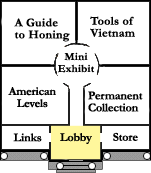

|
|
Table
of contents
|
|
A
Guide to Honing and Sharpening
Flattening
the Backs of Chisels and Plane Blades
Click
on the picture to enlarge
| |
A blade
has two sides. One side has the bevel, and it is the side which will
be honed. The other side is the back and it must be honed flat. The
reason for this is that unless the back of the blade is perfectly
flat before you start honing, it will be impossible to remove the
wire edge that is formed. |
|
Flattening
the back of a blade.
|
| |
Quality
tools should arrive from the store with a flat or almost flat back.
The situation in the past decade has improved quite a lot, and there
is no reason to accept drastically unflat backs. In truth, all we
really care about it the area immediately at the back of the cutting
edge. Even a consistent 1/64" is adequate. The way to tell if the
back of your tool is flat is simply to hone it for a few strokes
on an India stone. If the back is flat, you will see even grind
marks from the stone all along the cutting edge. If not, you have
work to do. Sometimes with new blades, the back seems perfectly
flat, with even grind marks all the way across, except at the actual
edge. This happens when a slight rounding at the tip occurs during
the manufacturing process. This is bad, the back must be flat and
have grind marks from your stone directly to the edge. Sometimes
the back will be perfect except for a tiny area near the cutting
edge. In that case, you may be able to work it out by leaning harder
on that area while honing the back. As stated before, all that is
required is the tiniest of flat honed areas at the edge. Everything
else is cosmetic. If the edge is drastically out of flat, you may
be forced to regrind the tool. If you consistently have trouble
getting a flat back, check your sharpening stones. While it is rare
for an India stone to be out of flat, it does occur, and waterstones
are notorious in not being flat.
|
| |
The
best way to flatten the back of a blade is to rub it vigorously on
the coarsest, largest flat stone you own. A coarse diamond stone is
perfect. Rougher stones are even better. Finer stones take longer.
You can also use course abrasive sheets on a thick peice of glass.
The technique for rubbing the back of a blade is the same as for honing
shown later in this article. But naturally the procedure takes longer
since we are trying to remove lots of metal. |
 |
Japanese
blades are usually hollow ground in the back to minimize the amount
of material that has to be removed when honing the back. This does
make flattening the back easier, but also can present a problem as
the blade is honed and the edge creeps into the hollow ground area.
In classic Japanese woodworking, when this happens, the bevel on the
front of the chisel is tapped with a hammer to force metal into the
hollow grind. However, if you routinely hone the back of the chisel
when you sharpen, enough material will be removed from the back so
that as the edge of the chisels recedes the area of the hollow grind
will recede too, thereby making tapping out the bevel from the front
unnecessary. |


|
